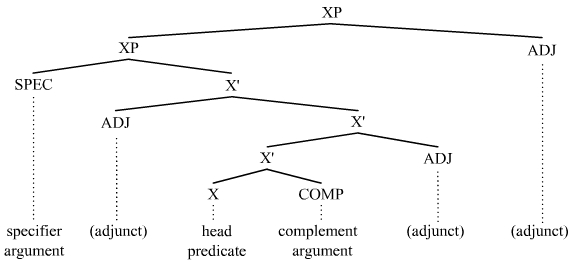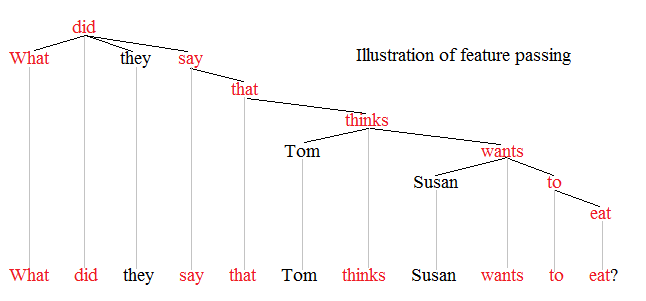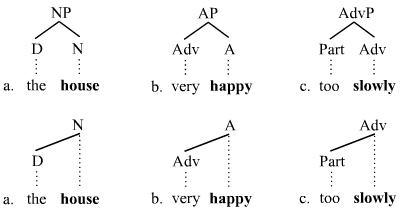|
Discontinuity (linguistics)
In linguistics, a discontinuity occurs when a given word or phrase is separated from another word or phrase that it modifies in such a manner that a direct connection cannot be established between the two without incurring crossing lines in the tree structure. The terminology that is employed to denote discontinuities varies depending on the theory of syntax at hand. The terms ''discontinuous constituent'', ''displacement'', ''long distance dependency'', ''unbounded dependency'', and ''projectivity violation'' are largely synonymous with the term ''discontinuity''. There are various types of discontinuities, the most prominent and widely studied of these being topicalization, wh-fronting, scrambling, and extraposition. Natural languages vary with respect to the types of discontinuities that they permit. The fixed word order of English allows for relatively few discontinuities compared to, for instance, the Slavic languages, which are much more permissive. Even compared to a closely ... [...More Info...] [...Related Items...] OR: [Wikipedia] [Google] [Baidu] |
Linguistics
Linguistics is the scientific study of human language. It is called a scientific study because it entails a comprehensive, systematic, objective, and precise analysis of all aspects of language, particularly its nature and structure. Linguistics is concerned with both the cognitive and social aspects of language. It is considered a scientific field as well as an academic discipline; it has been classified as a social science, natural science, cognitive science,Thagard, PaulCognitive Science, The Stanford Encyclopedia of Philosophy (Fall 2008 Edition), Edward N. Zalta (ed.). or part of the humanities. Traditional areas of linguistic analysis correspond to phenomena found in human linguistic systems, such as syntax (rules governing the structure of sentences); semantics (meaning); morphology (structure of words); phonetics (speech sounds and equivalent gestures in sign languages); phonology (the abstract sound system of a particular language); and pragmatics (how social con ... [...More Info...] [...Related Items...] OR: [Wikipedia] [Google] [Baidu] |
Verb Argument
In linguistics, an argument is an expression that helps complete the meaning of a predicate, the latter referring in this context to a main verb and its auxiliaries. In this regard, the ''complement'' is a closely related concept. Most predicates take one, two, or three arguments. A predicate and its arguments form a ''predicate-argument structure''. The discussion of predicates and arguments is associated most with (content) verbs and noun phrases (NPs), although other syntactic categories can also be construed as predicates and as arguments. Arguments must be distinguished from adjuncts. While a predicate needs its arguments to complete its meaning, the adjuncts that appear with a predicate are optional; they are not necessary to complete the meaning of the predicate. Most theories of syntax and semantics acknowledge arguments and adjuncts, although the terminology varies, and the distinction is generally believed to exist in all languages. Dependency grammars sometimes call argum ... [...More Info...] [...Related Items...] OR: [Wikipedia] [Google] [Baidu] |
Syntactic Movement
Syntactic movement is the means by which some theories of syntax address discontinuities. Movement was first postulated by structuralist linguists who expressed it in terms of ''discontinuous constituents'' or ''displacement''. Some constituents appear to have been displaced from the position in which they receive important features of interpretation. The concept of movement is controversial and is associated with so-called ''transformational'' or ''derivational'' theories of syntax (such as transformational grammar, government and binding theory, minimalist program). Representational theories (such as head-driven phrase structure grammar, lexical functional grammar, construction grammar, and most dependency grammars), in contrast, reject the notion of movement and often instead address discontinuities with other mechanisms including graph reentrancies, feature passing, and type shifters. Illustration Movement is the traditional means of explaining discontinuities such as w ... [...More Info...] [...Related Items...] OR: [Wikipedia] [Google] [Baidu] |
Minimalist Program
In linguistics, the minimalist program is a major line of inquiry that has been developing inside generative grammar since the early 1990s, starting with a 1993 paper by Noam Chomsky. Following Imre Lakatos's distinction, Chomsky presents minimalism as a program, understood as a mode of inquiry that provides a conceptual framework which guides the development of linguistic theory. As such, it is characterized by a broad and diverse range of research directions. For Chomsky, there are two basic minimalist questions — What is language? and Why does it have the properties it has? — but the answers to these two questions can be framed in any theory.Boeckx, Cedric ''Linguistic Minimalism. Origins, Concepts, Methods and Aims'', pp. 84 and 115. Conceptual framework Goals and assumptions Minimalism is an approach developed with the goal of understanding the nature of language. It models a speaker's knowledge of language as a computational system with one basic operation, namel ... [...More Info...] [...Related Items...] OR: [Wikipedia] [Google] [Baidu] |
Government And Binding Theory
A government is the system or group of people governing an organized community, generally a state. In the case of its broad associative definition, government normally consists of legislature, executive, and judiciary. Government is a means by which organizational policies are enforced, as well as a mechanism for determining policy. In many countries, the government has a kind of constitution, a statement of its governing principles and philosophy. While all types of organizations have governance, the term ''government'' is often used more specifically to refer to the approximately 200 independent national governments and subsidiary organizations. The major types of political systems in the modern era are democracies, monarchies, and authoritarian and totalitarian regimes. Historically prevalent forms of government include monarchy, aristocracy, timocracy, oligarchy, democracy, theocracy, and tyranny. These forms are not always mutually exclusive, and mixed governme ... [...More Info...] [...Related Items...] OR: [Wikipedia] [Google] [Baidu] |
Deep Structure And Surface Structure
Deep structure and surface structure (also D-structure and S-structure although those abbreviated forms are sometimes used with distinct meanings) are concepts used in linguistics, specifically in the study of syntax in the Chomskyan tradition of transformational generative grammar. The deep structure of a linguistic expression is a theoretical construct that seeks to unify several related structures. For example, the sentences "Pat loves Chris" and "Chris is loved by Pat" mean roughly the same thing and use similar words. Some linguists, Chomsky in particular, have tried to account for this similarity by positing that these two sentences are distinct ''surface forms'' that derive from a common (or very similar) deep structure. Origin Chomsky coined and popularized the terms "deep structure" and "surface structure" in the early 1960s. American linguist Sydney Lamb wrote in 1975 that Chomsky "probably orrowedthe term from Hockett". American linguist Charles Hockett first used the ... [...More Info...] [...Related Items...] OR: [Wikipedia] [Google] [Baidu] |
Transformational Grammar
In linguistics, transformational grammar (TG) or transformational-generative grammar (TGG) is part of the theory of generative grammar, especially of natural languages. It considers grammar to be a system of rules that generate exactly those combinations of words that form grammatical sentences in a given language and involves the use of defined operations (called transformations) to produce new sentences from existing ones. The method is commonly associated with American linguist Noam Chomsky. Generative algebra was first introduced to general linguistics by the structural linguist Louis Hjelmslev although the method was described before him by Albert Sechehaye in 1908. Chomsky adopted the concept of transformations from his teacher Zellig Harris, who followed the American descriptivist separation of semantics from syntax. Hjelmslev's structuralist conception including semantics and pragmatics is incorporated into functional grammar. Historical context Transformational analysi ... [...More Info...] [...Related Items...] OR: [Wikipedia] [Google] [Baidu] |
Something Happened
''Something Happened'' is Joseph Heller's second novel (published in 1974, thirteen years after ''Catch-22''). Its main character and narrator is Bob Slocum, a businessman who engages in a stream of consciousness narrative about his job, his family, his childhood, his sexual escapades, and his own psyche. Plot While there is an ongoing plot about Slocum preparing for a promotion at work, most of the book focuses on detailing various events from his life, ranging from early childhood to his predictions for the future, often in non-chronological order and with little if anything to connect one anecdote to the next. Near the end of the book, Slocum starts worrying about the state of his own sanity as he finds himself hallucinating or remembering events incorrectly, suggesting that some or all of the novel might be the product of his imagination, making him an unreliable narrator. ''Something Happened'' has failed to achieve the renown of ''Catch-22'' but has a cult following, wi ... [...More Info...] [...Related Items...] OR: [Wikipedia] [Google] [Baidu] |
Branching (linguistics)
In linguistics, branching refers to the shape of the parse trees that represent the structure of sentences. Assuming that the language is being written or transcribed from left to right, parse trees that grow down and to the right are ''right-branching'', and parse trees that grow down and to the left are ''left-branching''. The direction of branching reflects the position of heads in phrases, and in this regard, right-branching structures are ''head-initial'', whereas left-branching structures are ''head-final''. English has both right-branching (head-initial) and left-branching (head-final) structures, although it is more right-branching than left-branching. Some languages such as Japanese and Turkish are almost fully left-branching (head-final). Some languages are mostly right-branching (head-initial). Examples Languages typically construct phrases with a head word (or nucleus) and zero or more ''dependents'' (modifiers). The following phrases show the phrase heads in bold. ... [...More Info...] [...Related Items...] OR: [Wikipedia] [Google] [Baidu] |
Extraposition
Extraposition is a mechanism of syntax that alters word order in such a manner that a relatively "heavy" constituent appears to the right of its canonical position. Extraposing a constituent results in a discontinuity and in this regard, it is unlike shifting, which does not generate a discontinuity. The extraposed constituent is separated from its governor by one or more words that dominate its governor. Two types of extraposition are acknowledged in theoretical syntax: standard cases where extraposition is optional and ''it''-extraposition where extraposition is obligatory. Extraposition is motivated in part by a desire to reduce center embedding by increasing right- branching and thus easing processing, center-embedded structures being more difficult to process. Extraposition occurs frequently in English and related languages. Examples Standard cases of extraposition are optional, although at times the extraposed version of the sentence is strongly preferred. The following ... [...More Info...] [...Related Items...] OR: [Wikipedia] [Google] [Baidu] |
Scrambling (linguistics)
Scrambling is a syntactic phenomenon wherein sentences can be formulated using a variety of different word orders without any change in meaning. Scrambling often results in a discontinuity since the scrambled expression can end up at a distance from its head. Scrambling does not occur in English, but it is frequent in languages with freer word order, such as German, Russian, Persian and Turkic languages. The term was coined by Haj Ross in his 1967 dissertation and is widely used in present work, particularly with the generative tradition. Examples The following examples from German illustrate typical instances of scrambling: : These examples illustrate typical cases of scrambling in the midfield of a subordinate clause in German. All six clauses are acceptable, whereby the actual order that appears is determined by pragmatic considerations such as emphasis. If one takes the first clause (clause a) as the basic order, then scrambling has occurred in clauses b–f. The thre ... [...More Info...] [...Related Items...] OR: [Wikipedia] [Google] [Baidu] |



_Project_α.jpg)

.png)
